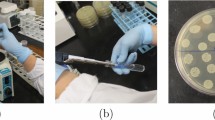Summary
Six different statistical methods for comparing limiting dilution assays were evaluated, using both real data and a power analysis of simulated data. Simulated data consisted of a series of 12 dilutions for two treatment groups with 24 cultures per dilution and 1,000 independent replications of each experiment. Data within each replication were generated by Monte Carlo simulation, based on a probability model of the experiment. Analyses of the simulated data revealed that the type I error rates for the six methods differed substantially, with only likelihood ratio and Taswell's weighted mean methods approximating the nominal 5% significance level. Of the six methods, likelihood ratio and Taswell's minimum Chi-square exhibited the best power (least probability of type II errors). Taswell's weighted mean test yielded acceptable type I and type II error rates, whereas the regression method was judged unacceptable for scientific work.
Similar content being viewed by others
References
Berkson, J. Minimum chi-square, not maximum likelihood!. Ann. Stat. 8:457–487; 1980.
Brett, S. J.; Kingston, A. E.; Colston, M. J. Limiting dilution analysis of the human T cell response to mycobacterial antigens from BCG vaccinated individuals and leprosy patients. Clin. Exp. Immunol. 68:510–520; 1987.
Cobb, L.; Schmehl, M. S.; Bank, H. L. A comparison of statistical methods for comparing limiting dilution assays. In Vitro 24:76–81; 1989.
Cohen, J. Statistical power analysis for the behavioral sciences. New York: Academic Press; 1969:1–39.
Fazekas de St. Groth, S. The evaluation of limiting dilution assays. J. Immunol. Methods 49:R11-R23; 1982.
Goldstein, A. Biostatistics, an introductory test. New York: The Macmillan Company; 1964.
Hoel, P. G. Introduction to mathematical statistics, 3rd ed. New York: John Wiley & Sons; 1962:224.
Huitema, B. E. The analysis of covariance and alternatives. New York: John Wiley & Sons; 1980:38–47.
Kynast, G.; Weber, E. Analysis of a limiting dilution assay by using the single-hit Poisson model—an APL computer program. EDV Med. Biol. 14:53–57; 1983.
Lefkovits, I.; Waldman, H. Statistical test, limitations and reproducibility. In: Limiting dilution analysis of cells in the immune system. England: Cambridge University Press; 1979:93–113.
Mao, S. J. T.; France, S. Enhancement of limiting dilution in cloning mouse myeloma-spleen hybridomas by human low density lipoproteins. J. Immunol. Methods 75:309–316; 1984.
McClave, J. T.; Dietrich, F. H. II. Statistics. San Francisco, CA: Dellen publishing Company; 1982:496–527.
Miller, R. A.; Stutman, O. T cell repopulation from functionally restricted splenic progenitors: 10,000-fold expansion documented by using limiting dilution analyses. J. Immunol. 133:2925–2932; 1984.
Taswell, C. Limiting dilution assays for the determination of immunocompetent cell frequencies: I. Data analysis. J. Immunol. 126:1614–1619; 1981.
Taswell, C. Limiting dilution assays for the separation, characterization, and quantitation of biologically active particles and their clonal progeny. In: Pretlow, T. G.; Pretlow, T. P., eds. Cell separation: methods and selected applications. vol 4. New York: Academic Press; 1987.
Author information
Authors and Affiliations
Rights and permissions
About this article
Cite this article
Schmehl, M.K., Cobb, L. & Bank, H.L. Power analysis of statistical methods for comparing treatment differences from limiting dilution assays. In Vitro Cell Dev Biol 25, 69–75 (1989). https://doi.org/10.1007/BF02624413
Received:
Accepted:
Issue Date:
DOI: https://doi.org/10.1007/BF02624413




